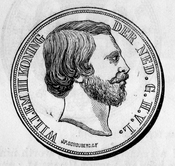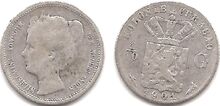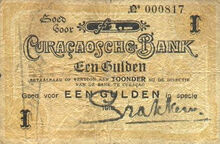The Netherlands Antillean guilder (Dutch: Antilliaanse gulden; code: ANG) is the currency of two of the five islands that formed the Netherlands Antilles up until 2010. It is subdivided into 100 cents (Dutch: centen). On January 1, 2011, the guilder was replaced by the United States dollar on the Caribbean Netherlands (Bonaire, Saba, and Sint Eustatius). The islands of Curaçao and Sint Maarten are expected to replace the Netherlands Antillean guilder with the newly created Caribbean guilder no earlier than 2013.
Etymology[]
In Papiamentu, the local language of Aruba, Bonaire, and Curaçao, the guilder is commonly referred to as a "florin". The ISO 4217 code, ANG is derived from ANtilleaanse Gulden, the name of the currency in Dutch, while the currency symbol, NAƒ, is derived from Netherlands Antilles Florin.
History[]

The Dutch guilder was formerly used in the Netherlands Antilles.
Before the introduction of the Netherlands Antillean guilder, the Dutch guilder was commonly used on the islands, as well as specific issues introduced in 1794 and 1799. In 1892, the currency was introduced in the form of banknotes, replacing the Dutch guilder on the Colony of Curaçao and Dependencies. Later, in 1900, coins were introduced. The name "Netherlands Antilles" was not appended to the territory or currency until 1952.
In 1940, after the German occupation of the Netherlands, the link to the Dutch guilder was broken, and the Netherlands Antillean guilder became pegged to the United States dollar at 1.88585 guilders = 1 dollar. In 1971, this was adjusted to 1.79 guilders = 1 dollar, though the official exchange rate has been fluctuating since.
In 1986, Aruba seceded from the Netherlands Antilles, and shortly after, began to issue its own currency, the Aruban florin, which replaced the guilder at par.
Coins[]

A 1⁄10 guilder coin from 1901.
In 1900 and 1901, the first coins of the Netherlands Antilles (then Curaçao and Dependencies) were minted in denominations of ¼ and 1⁄10 guilder, respectively. These circulated alongside the Dutch coins within the colony. After Germany's occupation of the Netherlands, a bronze 1 cent coin was introduced in 1942, followed by a cupronickel 5 cent coin in 1943, a bronze 2½ cent coin and silver 1 and 2½ guilder coins in 1944. The coins from 1941 to 1944 were minted by the United States, and carried "D" and "P" mint marks, and on most, a small palm tree. The coinage was also intended to be used in Suriname, which did not become independent until 1975.
In 1952, the name "Nederlandse Antillen" made its debut on the Netherlands Antillean 1 cent and 1 gulden coins. During 1954, new 1⁄10 and ¼ guilder coins were introduced, followed by 2½ cents in 1956, 5 cents in 1957, and 2½ guilder in 1964. In 1970, the 1⁄10 and ¼ guilder coins were replaced by 10 and 25 cent coins, respectively, and in 1998, the 5 guilder coin was introduced. After about 90 years of coin production in the Netherlands Antilles, it ceased in 2010.
Commemorative coins with denominations of 5, 10, 25, 50, 75, 100, 200, and 300 gulden have been issued, and in 2011, special-edition coins of the islands of Bonaire, Sint Eustatius, and Saba were also introduced.
Banknotes[]

A 1 gulden banknote from 1918.
During 1892, the Curaçaosche Bank introduced notes in denominations of 25 and 50 cents, 1 and 2½ guilders. In 1900, notes were printed in denominations of 5, 10, 25, 50, 100, 250, and 500 guilders were issued. The 1 and 2½ guilder notes were removed from circulation after 1920, but were reintroduced in 1942 as muntbiljet.
Beginning in 1952, the name "Nederlandse Antillen" appeared on the reverses of the banknotes of the Curaçaosche Bank. In 1962, the name of the central bank was changed to the Bank van de Nederlandse Antillen, and was later changed in 2010 to the Central Bank of Curaçao and Sint Maarten.
Exchange rates[]
| Current ANG exchange rates | |
|---|---|
| From Google Finance [1]: | AUD CAD CHF EUR GBP HKD JPY USD |
| From Yahoo! Finance [2]: | AUD CAD CHF EUR GBP HKD JPY USD |
| From OzForex [3]: | AUD CAD CHF EUR GBP HKD JPY USD |
| From XE.com [4]: | AUD CAD CHF EUR GBP HKD JPY USD |
| From OANDA.com [5]: | AUD CAD CHF EUR GBP HKD JPY USD |
References[]
Template:Antillean guilder
